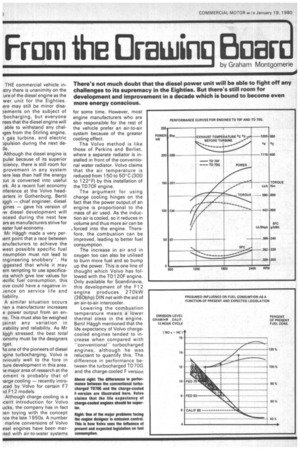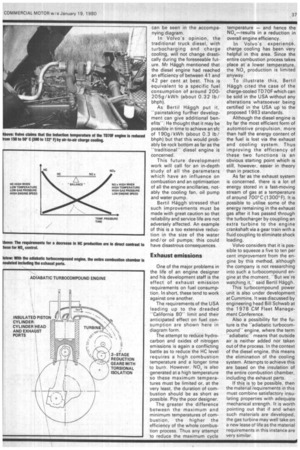From the Orewinq 13021 by Graham Montgomerie There's not much
Page 38

Page 39

If you've noticed an error in this article please click here to report it so we can fix it.
doubt that the diesel power unit will be able to fight off any challenges to its supremacy in the Eighties. But there's still room for development and improvement in a decade which is bound to become even more energy conscious.
THE commercial vehicle inistry there is unanimity on the :ure of the diesel engine as the wer unit for the Eighties. ere may still be minor disasements on the subject of -bocharging, but everyone rees that the diesel engine will able to withstand any chaliges from the Stirling engine, gas turbine, and electric )pulsion during the next dede.
Although the diesel engine is pular because of its superior iciency, there is still room for provement in any system lere less than half the energy )ut is converted into useful Kk. At a recent fuel economy nference at the Volvo headarters in Gothenburg, Bertil iggh — chief engineer, diesel gines — gave his version of lw diesel development will oceed during the next few ars as manufacturers strive for eater fuel economy.
Mr I-Wggh made a very perrent point that a race between anufacturers to achieve the west possible specific fuel nsurnption must not lead to wigineering snobbery". He Iggested that while it may em tempting to use specifica ms which give low values for recific fuel consumption, this ove could have a negative inJence on service life and liability.
A similar situation occurs hen a manufacturer increases e power output from an en ne. This must also be weighed lainst any variation in Jrability and reliability. As Mr Jggh stressed, the best total :onomy must be the designers rget.
ks one of the pioneers of diesel igine turbocharging, Volvo is wiously well to the fore in ture development in this area. le major area of research at the oment is probably that of large cooling — recently introiced by Volvo for certain F7 id F12 models.
.Although charge cooling is a !cent introduction for Volvo ucks, the company has in fact .,en toying with the concept rice the late 1950s. A number marine conversions of Volvo esel engines have been marqed with air-to-water systems for some time. However, most engine manufacturers who are also responsible for the rest of the vehicle prefer an air-to-air system because of the greater cooling effect.
The Volvo method is like those of Perkins and Berliet, where a separate radiator is installed in front of the conventional water radiator. Volvo claims that the air temperature is reduced from 150 to 50°C(300 to 122°F) by this installation of the TD7OF engine.
The argument for using charge cooling hinges on the fact that the power output. of an engine is proportional to the mass of air used. As the induction air is cooled, so it reduces in volume and thus more air can be forced into the engine. Therefore, the combustion can be improved, leading to better fuel consumption. The increase in air and in oxygen too can also be utilised to burn more fuel and so bump up the power. This is one line of thought which Volvo has followed with the TD120F engine. Only available for Scandinavia, this development of the F12 engine produces 270kW (360bhp) DIN net with the aid of an air-to-air intercooler.
Lowering the combustion temperature means a lower thermal stess in the engine. Bertill-idggh mentioned that the life expectancy of Volvo chargecooled engines tended to increase when compared with "conventionalturbocharged engines, although he was reluctant to quantify this. The difference in performance between the turbocharged TD7OG and the charge-cooled F version
can be seen in the accompanying diagram.
In Volvo's opinion, the traditional truck diesel, with turbocharging and charge cooling, will not change drastically during the foreseeable future. Mr Hdggh mentioned that the diesel engine had reached an efficiency of between 41 and 42 per cent at best. This is equivalent to a specific fuel consumption of around 200205g /kVVh (about 0.32 lb/ bhph).
As Bertil Ha,ggh put it, "painstaking further development can give additional benefits". He thought that it may be possible in time to achieve an sfc of 190g /kWh (about 0.3 lb/ bhph) but that this would probably be rock bottom as far as the "traditional"' diesel engine is concerned.
This future development work will call for an in-depth study of all the parameters which have an influence on combustion and an optimisation of all the engine ancillaries, notably the cooling fan, oil pump and water pump.
Bertil Haggh stressed that such improvements must be made with great caution so that reliability and service life are not adversely affected. An example of this is a too extensive reduction in the size of the water and /or oil pumps; this could have disastrous consequences.
Exhaust emissions
One of the major problems in the life of an engine designer and his development staff is the effect of exhaust emission requirements on fuel consumption. In short, these tend to work against one another.
The requirements of the USA leading up to the dreaded "California 80" limit and their anticipated effect on fuel consumption are shown here in diagram form.
The attempt to reduce hydrocarbon and oxides of nitrogen emissions is again a conflicting battle as to reduce the HC level requires a high combustion temperature and a longer time to burn. However, NO, is also generated at a high temperature so these maximum temperatures must be limited or, at the very least, the duration of combustion should be as short as possible. Pity the poor designer.
The greater the difference' between the maximum and minimum temperatures of combustion, the higher the efficiency of the whole combustion process. Thus any attempt to reduce the maximum cycle temperature — and hence the NO„—results in a reduction in overall engine efficiency.
In 'Volvo's experience, charge cooling has been very helpful in this area. Since the entire combustion process takes place at a lower temperature, the NO production is limited anyway.
To illustrate this, Bertil Haggh cited the case of the charge-cooled TD7OF which can be sold in the USA without any alterations whatsoever being certified in the USA up to the proposed 1983 standards.
Although the diesel engine is by far the most efficient form of automotive propulsion, more than half the energy content of the fuel is lost via the exhaust and cooling system. Thus improving the efficiency of these two functions is an obvious starting point which is still, however, easier in theory than in practice.
As far as the exhaust system is concerned, there is a lot of energy stored in a fast-moving stream of gas at a temperature of around 700°C (1300°F). It is possible to utilise some of the energy remaining in the exhaust gas after it has passed through the turbocharger by coupling an extra turbine to the engine crankshaft via a gear train with a fluid coupling to eliminate shock loading.
Volvo considers that it is possible to squeeze a five to ten per cent improvement from the engine by this method, although the company is not researching into such a turbocompound engine at the moment. -But we're watching it," said Bertil Haggh.
This turbocompound power unit is also under development at Cummins. It was discussed by engineering head Bill Schwab at the 1978 CM Fleet Management Conference.
Also a possibility for the future is the "adiabatic turbocompound' engine, where the term "adiabatic" means that outside air is neither added nor taken out of the process. In the context of the diesel engine, this means the elimination of the cooling system. Attempts to achieve this are based on the insulation of the entire combustion chamber, including the exhaust parts.
If this is to be possible, then the material requirements in this must combine satisfactory insulating properties with adequate mechanical strength. It is worth pointing out that if and when such materials are developed, the gas turbine may well take on a new lease of life as the material requirements in this instance are very similar.












































































































